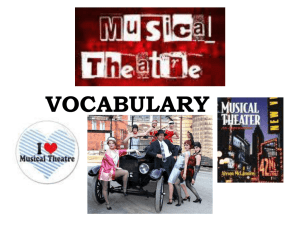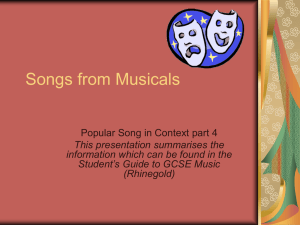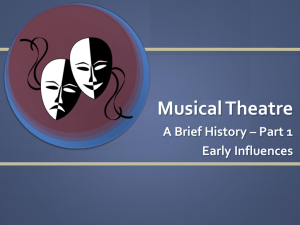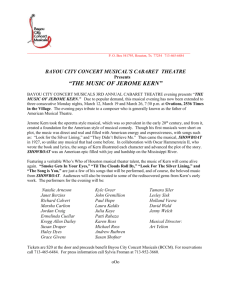Learning P ack - Wales Millennium Centre
advertisement
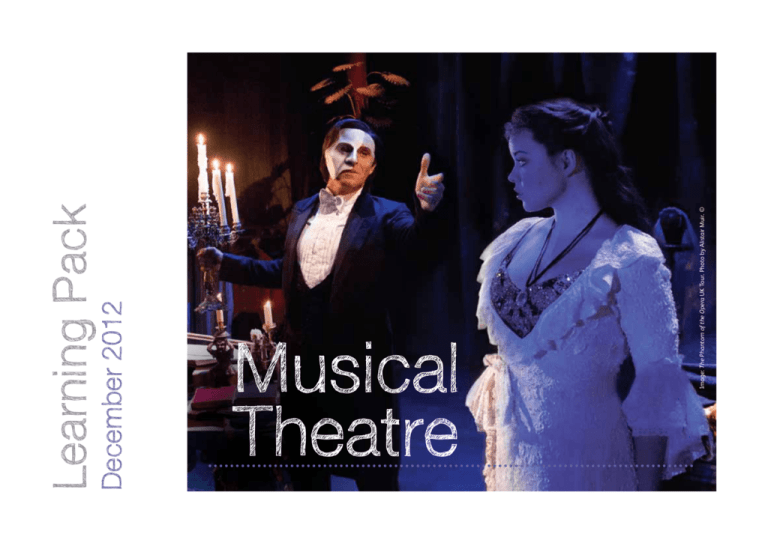
December 2012 Learning Pack Image: The Phantom of the Opera UK Tour. Photo by Alistair Muir. © Musical Theatre Musical Theatre Learning Pack Introduction Musical Theatre is a broad genre with a number of different areas to explore. This learning pack has been created to give you an insight into the genre and is designed for anyone to access, at home, in school or even if you just have an interest. Our Musical Theatre Learning Pack supports our Musicals Learning Week, which has been inspired by The Phantom of the Opera which will be performed in our Donald Gordon Theatre this Christmas. Contents Musical Theatre page 3-6 The Phantom of the Opera page 7-8 Wales in the West End page 9 Mini interview with Sharon Calcutt – West End Stage Manager page 10 Image: Oliver! Photo by Alistair Muir. © 2 Musical Theatre Learning Pack Musical Theatre Musical Theatre, or Musicals, has played a big part of our popular culture since the early 20th Century. Musicals tend to use music and song more than spoken word to tell us a dramatic story. Musicals are enjoyed as much today as they were when they first started out and it is a genre of theatre that continues to grow. London’s West End was the original hub for Musicals, but shortly after Broadway in New York City joined the craze and both areas are still renowned theatre hotspots. Image: American Idiot UK Tour. © ‘Who could resist the toe-tapping dancers of 42nd Street, or the gold top hats in Chorus Line. You have all the bright colours of Joseph’s coat and the red and black flags of revolution, rainbows to climb over and mysteries to solve. Mary Poppins soars over your head. Chandeliers come crashing down. A lion made out of string will break your heart, and puppets will fall in love over mix tapes. Villages disappear for centuries at a time. Kate will most definitely be kissed. Trains roll on past. Argentina is lost and won. Witches aren’t always bad and Dorothy has got some new shoes…’ Sharon Calcutt – West End Stage Manager on why musical theatre is so popular. You can read more from Sharon later on. Image: Dirty Dancing UK Tour. © 3 Musical Theatre Learning Pack Songs are one of the most important elements of any Musical Theatre productions. Audiences are captured by the great songs, those hits that you sing out loud in the theatre and the catchy tunes that stay in your head for the rest of the week. There are lots of different types of songs in Musical Theatre which are all integral to the structure of the plot: Action Songs – these help keep the plot going so we can move on to different scenes. Character Songs – these are there to help us learn more about the different characters. The characters can tell us how they feel or give us more background information about themselves in these songs. It is easy to forget that although Charles Dickens created Oliver and his ragamuffin friends, he didn’t write the songs ‘Food Glorious Food’ or ‘Consider Yourself’. You’d also be forgiven for forgetting that Andrew Lloyd Webber based The Phantom of the Opera on a French novel that was originally published in 1909 and that The Sound of Music’s Maria Von Trapp was actually a real woman, not just a character created by Rodgers and Hammerstein. But these few examples show us how almost anything could inspire a musical. As well as novels, stage musicals have been created from films, poems and even popular music. Many of our favorite films have been adapted for the stage and can now be enjoyed as live performance experiences. Spider-Man, Sister Act and even The Lion King are some of today’s most famous stage shows. Production Songs – these usually involve most or all of the company. Often they are at the beginning or end of a new scene or tell us about a big change that has happened such as a new location. Richard Rodgers and Oscar Hammerstein, are a renowned songwriting duo who wrote predominantly in the 1940s/50s. They are known for their contribution to Musical Theatre after writing an array of musical blockbusters that are still being produced today. Musicals are usually spectacles. Their budgets are often larger than other forms of theatre so the companies can be really imaginative with their effects, costumes and sets. You can see everything in a Musical from a life-sized elephant in The Lion King, to the flying car in Chitty Chitty Bang Bang and even Gollum in The Lord of the Rings, who can creep and crawl down a vertical wall. There are a number of different types of Musicals and they are inspired by a number of different things. This variety means there is likely to be something to appeal to everyone and may be the key to the success of the art form. Image: Sister Act UK Tour. Photo by Tristram Kenton. © 4 Musical Theatre Learning Pack ‘Oscar Wilde the Musical’ goes down in history as the shortest-running musical. It was written for the anniversary of the poet’s death and ran for just one night in London before closing due to poor ticket sales. Jukebox Musicals are increasingly popular they are constructed around popular songs which have been previously released and are usually by artists who have a large existing fan base. For example, the ever-popular Mamma Mia! uses the songs of popular Swedish band ABBA and Ben Elton’s We Will Rock You is based around Queen’s hits. Adaptation has played a big role in the creation of many Musicals. With the right creative team, almost anything can be transformed for the stage. As previously mentioned, popular films have been a common starting point. Films that can already be regarded as Musicals transfer smoothly to the stage allowing audiences to enjoy songs that are already popular in a new way. Hairspray, Sister Act and Grease are just a few good examples of this. Writers and producers can also be very creative and have taken popular films that are not musicals and turned them into musical theatre. Shows such as Dirty Dancing, Legally Blonde and Flashdance are just a few and they have been helped by their recognisable film soundtracks. The use of puppets and costume have also helped to adapt animated musical films to the stage and as a whole has been very effective, with productions such as The Lion King and Shrek The Musical seeing huge success. Activity – Adaptation: KS 3/4 Links to English & PSE developing thinking and communication. Image: Little Star Services (Europe) Limited / Nick Grace Management LTD. © As well as these two successful shows, the Centre has welcomed a number of Jukebox Musicals over the years, including Saturday Night Fever (Bee Gees), Tonight’s the Night (Rod Stewart) and even American Idiot (Green Day). In 2007, the Centre also premiered Never Forget based on the music of Take That. In Jukebox Musicals the songs are used to create and explain a dramatic plot which can be about the performer whose music is featured. Often, however, the plot is not connected to the artist and is instead a well-crafted story woven around the songs. We have looked at how popular it has been to adapt books, films and music into live stage shows. Can you think of a story that you think would make a good piece of musical theatre? Write a pitch as though you are selling the idea to a top producer. You have to think about why that story would adapt well and what style of musical it would become. What are the key events in the story and who are the main characters? Also think about who the audience would be so you know how to market it. It might also help your pitch to have some catchy song titles ready as the music is one of the biggest attractions. The critical and commercial success of Jukebox Musicals has been uneven. Some, such as Lennon, have closed after a short season, while others including Mamma Mia!, Jersey Boys and Buddy have become hugely successful. 5 Musical Theatre Learning Pack Andrew Lloyd Webber is known predominantly as a composer but has his fair share of production credits. He has also become a familiar face on television with his musical casting shows that are responsible for jumpstarting the careers of several popular musical theatre performers. Mega-musicals developed in the 1980s and 1990s. Mega-musicals or Pop/Rock Operas typically feature a pop-influenced score and have large casts, sets and effects. These effects are often as famous as the songs – technical elements such as a falling chandelier (in The Phantom of the Opera), a helicopter landing on stage (in Miss Saigon) and a woman flying right over the audience (in Mary Poppins). These technically impressive productions are incredibly expensive to create but the best mega-musicals can run for decades. Les Misérables was the first mega-musical with genuine dramatic merit and has now reached its 25th anniversary. Audiences can’t get enough of the anthemic songs and engrossing storyline. The British composer Andrew Lloyd Webber, saw similar mega-success with Evita, based on the life of Argentina’s Eva Perón, and Cats. Other Lloyd Webber musical successes include Starlight Express, performed on roller skates; The Phantom of the Opera, and Sunset Boulevard (from the classic film of the same name). Several of these works ran, or are still running, for decades in both New York and London. The 1990s also saw the influence of large corporations on the production of musicals. The most important has been The Walt Disney Company, which began adapting some of its animated movie musicals for the stage, including Beauty and the Beast and The Lion King. Image: Les Misérables. Photo by Michael le Poer Trench. © Activity – 5 Minute Musical: KS 2 Music and PSE developing thinking and communication. This is also a very good drama exercise. Work in a group to make a 5 Minute Musical. You can use a musical you know or be creative and make your own. Think carefully about the story and work out what information is the most important for the audience to know. You’ll want to make sure it works as a story so has a beginning, middle and an end. Also which characters do you think you need to keep? Also remember that songs can help set the scene quickly or give lots of information about a character so use songs to help you. 6 The Phantom of the Opera Musical Theatre Learning Pack ‘Far beneath the majesty and splendour of the Paris Opera House, hides the Phantom in a shadowy existence. Shamed by his physical appearance and feared by all, the love he holds for his beautiful protégée Christine Daaé is so strong that even her heart cannot resist.’* Cameron Mackintosh’s spectacular new production of Andrew Lloyd Webber’s The Phantom of the Opera is at Wales Millennium Centre over Christmas 2012. This musical is based on the novel Le Fantôme de l’Opéra by the eccentric French author, Gaston Leroux, which was published in 1911. Leroux was thought to have a real passion for the theatrical and captured a lot of that passion and theatrical knowledge in this story. Prior to the publication of Le Fantôme de l’Opéra, Leroux hadn’t been a very successful playwright and was studying Law. Even after its publication, he did not see much more success as an author. The reviews were bad and the sales were not very high. One of the only things to really come from Leroux novel was a serialisation of it for a newspaper. This serial was then spotted by Universal Pictures and caught their interest. In 1925, Universal Pictures’ The Phantom of the Opera was first screened and since then the story has grown and grown. Today, people are most likely to come across the story in the form of the musical version composed by Andrew Lloyd Webber and famed for its spectacular production. The Phantom of the Opera is really a musical about the theatre and all its secrets, grandeur, glamour and hard work. The Phantom’s story takes us backstage, behind the scenes, behind the “mask” of the theatre. After the prologue of The Phantom of the Opera, we see an army of dancing slaves and an elephant, rearing its powerful head, carrying the great warrior Hannibal. But wait! A voice calls out, correcting “Hannibal’s” pronunciation of the word “Rome.” The elephant turns, revealing two stagehands controlling its movements. We are suddenly where few are ever allowed: in the heady atmosphere of a rehearsal. The story of The Phantom of the Opera allows us a glimpse of how the illusion of the theatre is created, but the story behind the musical is an adventure of determination, talent and risk that Leroux himself would have envied.* “The Phantom of the Opera is about something very basic. The story of the ugly man in love with the beautiful woman goes back to mythology. Everyone is fascinated by the idea, and that’s why Phantom has remained so popular.” Maria Björnson (Set and Costume Designer for the original production). * The information in this article was sourced from the official website for The Phantom of the Opera, thephantomoftheopera.com. A study guide is also available on this website should you like to read more. 7 Musical Theatre Learning Pack Touring musicals vary in size. A smaller musical that does short runs might need around 3 large lorries to move all of their sets and equipment. However, the larger mega-musicals that may stay in a venue for weeks at a time can use up to 19 lorries! Cameron Mackintosh is one of the most successful and famous producers on the musical theatre scene today. He has produced over 40 different musicals and owns seven theatre’s in London’s West End. The Composer: Giving the Mask a Voice On a cold February morning in 1984, producer Cameron Mackintosh received a phone call while taking a bath. It was Andrew Lloyd Webber, the composer of Jesus Christ Superstar, Cats, Evita, Song and Dance and Starlight Express, with whom he had co-produced Cats and Song and Dance. It proved to be a fateful call. Mackintosh remembered later, “His first words were ‘If I said to you The Phantom of the Opera, what you would say?’ Even in my prune-like condition, I recognized Andrew had come up with another good idea. We screened copies of the original Lon Chaney movie and the later Claude Raines version. Though very enjoyable, neither one made us shout Eureka! So we decided to find a copy of the original Leroux novel.” Reading Leroux’s story excited them both (the novel was then out of print; Lloyd Webber found a copy in a New York secondhand bookstore, and Mackintosh found one in his aunt’s garage). Here was not a simple horror story, but a dark heartbreaking tale of unrequited love. The initial press release in 1984 stated, “The score for The Phantom of the Opera will include both existing and original work.” The original idea was to use mainly famous classical and operatic works for the score. But as Lloyd Webber reread the Leroux novel, he grew more and more convinced that he should write the music. In the Phantom’s yearnings, Lloyd Webber felt his own need to write a romantic score. With lyricist Richard Stilgoe, they presented a draft of the first act of the show in a private music festival at Lloyd Webber’s home during the summer of 1985. Image: The Phantom of the Opera UK Tour. © Once the score and script are well underway it is time to get the rest of the production team on board. Camron Macintosh recruited a skilled and experienced team including set & costumer designer, lighting designer and sound designer, along with choreographer and the actors. This production of The Phantom of the Opera is now celebrating its 25th Anniversary. It is a dramatic story that attracts a very varied audience and with its ornate sets and costumes, along with its intense score, is likely to continue being as popular for years to come. The information in this article was sourced from the official website for The Phantom of the Opera, thephantomoftheopera.com. 8 Wales in the West End Musical Theatre Learning Pack Over the past 8 years, the Centre has been host to some of the biggest musicals to have come out of the West End; so we thought we’d take a look at some of the home-grown talent that in turn has taken Wales to the West End. It’s inspiring to see how many Welsh stars have taken Wales to the West End and beyond and there are many more that we could have included too. With the massive global economy booster that musicals are, it’s great to see that the Welsh are at the heart of all that success. We start with Cardiff born Ivor Novello, one of the most popular British entertainers of the early 20th century; most notably for his significant contribution to music and musicals. Another beloved Welsh star of the stage was Harry Secombe from the St Thomas district of Swansea. His powerful voice allowed him to appear in many stage musicals, which included Pickwick, where he sang “If I Ruled the World” – later to become his signature tune. Throughout their careers, both Aled Jones and John Owen-Jones have achieved great successes treading the boards; Aled has starred in both Joseph and his Technicolour Dream Coat and Chitty Chitty Bang Bang while John Owen-Jones’ performance as Jean Valijean demanded standing ovations during the 25th year anniversary tour of Les Misérables. The production was also one of the highlights of the Centre’s 5th Birthday celebrations in 2009. Raised in Haverfordwest, Connie Fisher’s triumph during BBC’s talent contest How Do You Solve a Problem like Maria? earned her a place as Maria in the Sound Of Music and she recently returned to the Centre in Wonderful Town. Peter Karrie was born in the Vale of Glamorgan, and is celebrated all over the world for his leading role in Andrew Lloyd Webber’s The Phantom of the Opera. He has also enjoyed great successes in Les Misérables, Chess, Annie and Oliver! to name but a few. Finally, we have Jonathon Pryce and Daniel Evans. Holywell born Pryce won a Tony award for his performance in the role of the Engineer in Miss Saigon while Daniel Evans went from winning the Richard Burton award as a young man at the National Eisteddfod to a two-time winner of the Laurence Olivier Award; one for his performance in Merrily We Roll Along, and the other for Sunday in the Park with George. Image: The Sound of Music (David Ian Productions Ltd). © 9 Musical Theatre Learning Pack Tell us about your job. I am a stage manager, which means that I’m in charge of making sure that everything and everyone are in the right place, at the right time, with the right props! Mini interview with Sharon Calcutt West End Stage Manager How did you get involved with the theatre? Well, I originally trained as a musician and have always been involved with theatre. When I got injured and couldn’t play anymore it was the next logical step. It felt like the right place for me in the world. I could do both things that I loved, and be paid for it. Activity – Setting The Scene: KS 2/3 & 4 Art & Design and PSE developing thinking. Pick a story you know really well and think of just one part of it, one scene. Imagine it as a big Musical and design the set and lighting for that scene. Where would it be set? Would there be any special effects? Would the lighting be dark and still or colourful and moving? Remember Musical Theatre doesn’t have many limits so you can be really creative. Which part of your job do you enjoy the most, and why is that? I enjoy being able to achieve the impossible. With musicals in particular, stage management are often under pressure to deliver outstanding results. You get to press night and the opening number runs smoothly because of you and your team, and you’ve got a hit! It’s just a wonderful feeling. From working within the industry, why do you think the Musical is such a successful part of popular culture? If there is one thing that makes it popular it’s that musical theatre has something for everybody, and it’s presented in such a way that people can’t help but enjoy it. In a world that is getting tougher and more anonymous to walk through, Musical Theatre offers two and a half hours of escapism that can transport you away, and a good song and a bit of sparkle will stay with you for the rest of your life. 10


